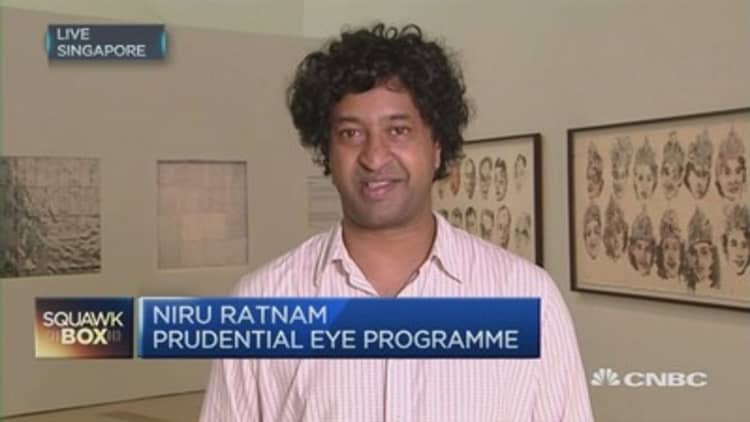Southeast Asian art has been enjoying greater recognition in recent years but is it a worthwhile investment?
The answer depends on who you ask.
That Southeast Asian art is making waves globally is not in doubt. There has been greater exposure at art exhibitions and international art fairs among other platforms. Some artworks have been sold at dizzying prices, notably the 2014 sale of "Pasukan Kita Yang Dipimpin Pangeran Diponegoro" (Our Soldiers Led Under Prince Diponegoro) by modern Indonesian artist S. Sudjojono. It went under the hammer for $7.48 million (HK$58.36 million) in Hong Kong.
However, whether the market is ripe for investors to step in is another matter altogether.
Low Sze Wee, director of curatorial & collections at the National Gallery Singapore, is one of the doubters. The National Gallery Singapore, which opened in November last year, has one of the world's largest collections of modern Southeast Asian art and presents regional exhibits that help viewers understand more about the Southeast Asian art and culture.
Low's message: "nobody knows" which artwork will appreciate in value, if at all.
"I would actually urge people not to think of art as an investment, there are more rational ways of investing your money than in art," says Low in a CNBC interview.
"The appreciation of Southeast Asian art in financial terms is so hard to predict, that you would be assured that you wouldn't lose too much money only if you buy art at the higher-end," he adds.
Major auction houses such as Christie's and Sotheby's appear to disagree with the National Gallery Singapore director's observations, noting that the region's arts have reported price growth in the past few years.
Art in Southeast Asia has seen almost "20-30 percent growth over the last five to ten years but it still depends on factors such as the rarity, provenance, and condition of the piece," says Dexter How, Southeast Asian art specialist at the London-based auction house Christie's.
Southeast Asian art had generally contributed around 15-17 percent of total sales for Christie's auctions, but last year, this category accounted for 25 percent of total Asian art sales in November.
"The demand is coming from [within] the region, but we've also seen demand growth from greater Asia, Europe and U.S. collectors," says How.
The highest amount paid for a single Southeast Asian artwork sold by Christie's was Singaporean artist Lee Man Fong's "Bali Life" which sold for $3.24 million in 2010.
Mok Kim Chuan, head of modern and contemporary Southeast Asian Art at Sotheby's, which sold the Sudjojono artwork, notes that many collectors are looking at Southeast Asian art more seriously, which should help in its internationalization.
"Prices for Southeast Asian Art are getting stronger and sales are going from strength to strength," Mok says.
One thing that the auction houses and National Gallery Singapore can all agree on is that art from Indonesia and Philippines make up the bulk of the region's demand.
The experts say that this is because both Indonesia and Philippines have an older art history and practice of art collection.
Understanding Southeast Asian art
As a whole, Southeast Asian art is still young as it is less than 200-years old, according to Low from the National Gallery Singapore.
"The art history is still being written, and we're still developing the scholarship," says Low.
The National Gallery Singapore director also explains that geopolitics is another reason why Southeast Asian art has some way to go before gaining international prominence.
"Southeast Asia doesn't generate as much headlines as the Middle East, and there are also far larger countries in Asia, both economically and politically," he says, adding that most people might not know the difference between Malaysia and Indonesia.
Low advises museum-goers or art lovers to "always look at art with a greater amount of sensitivity," said Low.

A viewer unfamiliar with Southeast Asian art might see resemblances to Vincent van Gogh's works when looking at modern Indonesian artist Affandi, because of the brushstrokes and style, says Low.
The next natural conclusion then is that Affandi's work must be derivative or an imitation of van Gogh's, who is the earlier artist, says Low.
"This creates negative connotations, and I don't think that's a very productive way of looking at art because influence is always dynamic," he adds, using the example of Pablo Picasso who was inspired by African art which helped shaped his Cubism style.
Greater sensitivity when looking at art means to understand the specific context in which the artist came from.
Low explains that with regards to Affandi, viewers need to understand Indonesia, and what Indonesia was like when Affandi created his works. By understanding the circumstances Affandi grew up in, and how it shaped him, he then becomes an equally interesting person as van Gogh.
"We are all influenced by the various factors around us."


